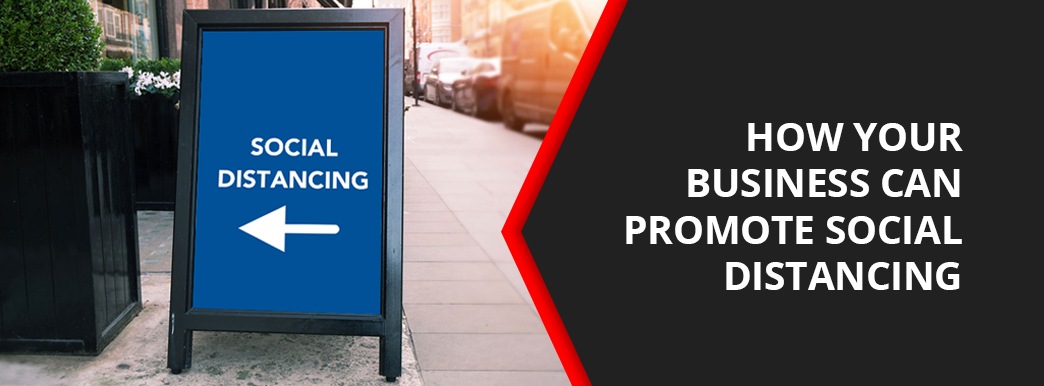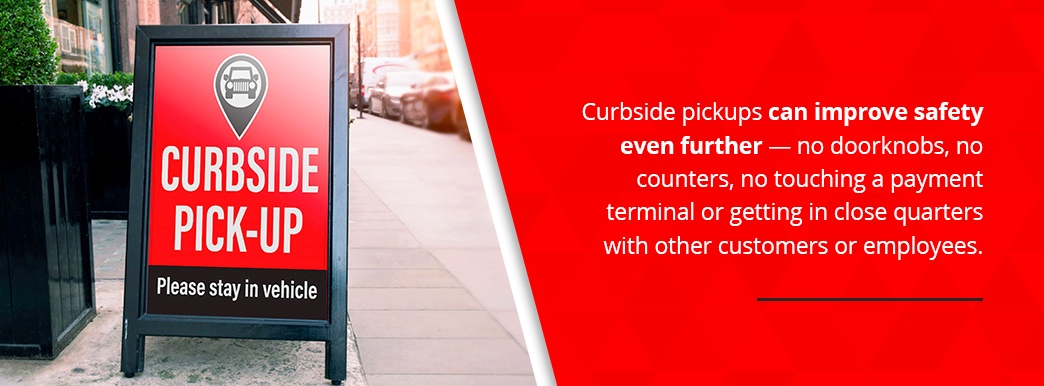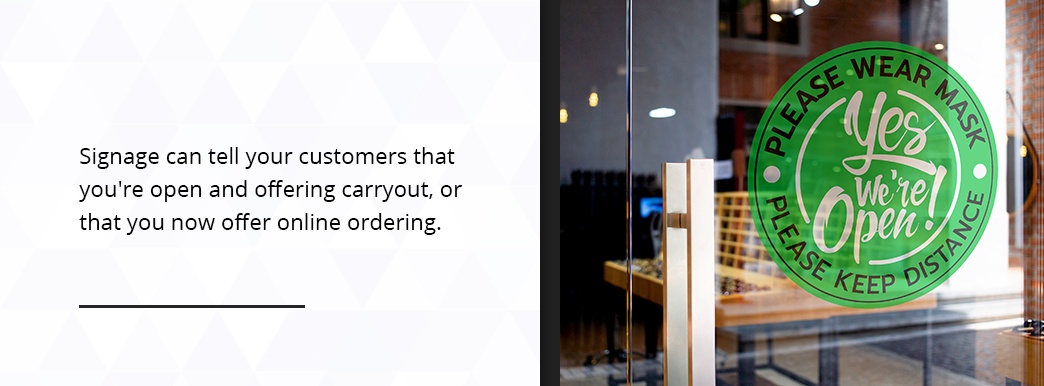
How Your Business Can Promote Social Distancing
MAY 27, 2020| SpeedProAs the world learns how to adapt to and maneuver the COVID-19 pandemic, one measure stands out, and that’s social distancing. Social distancing is a method endorsed by the Centers for Disease Control (CDC) for reducing the spread of the virus by standing at least 6 feet away from others at all times in public spaces.
Of course, you can’t always control how your clients and customers behave, so promoting social distancing rules and behaviors can help you get them to abide by these measures, understand their importance and keep everyone safer.
Emphasize the Importance of Social Distancing
While you won’t be able to give your customers a science lesson every time they walk through your doors, you can talk to employees about the modes of transmission and clarify it for any customers who may not know what it entails. Understanding why we use social distancing can help clear the air and shows employees why it is critical throughout their shifts. It can also inform your signage and social distancing measures.
We have created some free signs for businesses promoting safe behaviors regarding COVID-19 to use.
Since COVID-19 has no vaccine yet, the CDC has said that prevention is the best defense. The virus seems to spread from person-to-person contact, so if people are within about 6 feet of each other, there is a greater chance of them transmitting the virus. As someone talks, coughs or sneezes, they create respiratory droplets that can travel between people. These droplets can then land in the respiratory system of others through their mouth, nose or inhalation.
The droplets are mainly why we promote social distancing, to keep people outside of the space where they can spread it to each other. They’re also the reason we use masks, to prevent spreading droplets wherever we go.
A couple of crucial misconceptions may come up or require clarification:
- Wearing a mask is not a substitute for social distancing. While masks are a big help in protecting those around you, they aren’t as effective as avoiding contact altogether, especially if the mask is simply cloth. Most consumer face coverings are going to be made of fabric, as medical-grade supplies are typically rerouted to medical facilities at the moment.
- Even people who don’t show symptoms can carry and transmit the virus, so being perfectly healthy is no reason to neglect social distancing. It could be a danger to those around the person, especially if they’re in contact with high-risk populations like older adults or immunocompromised people.
However annoying some of these measures may be, we must still abide by them to flatten the curve and keep as many people healthy as possible.
While staying home is the best way to stay safe, everyone has things they need to get done, whether for work or everyday life. Visiting grocery stores, pharmacies and many other essential businesses still needs to be a common occurrence for most people. So how can we keep them safe and keep the companies moving? Social distancing is one of the most important methods of preventing the spread of the virus. Let’s take a look at how you can encourage your clientele to social distance and keep themselves, other customers and your employees safe.
Put Up Signs
Probably the most ubiquitous approach to conveying social distancing rules is to use signs. Coronavirus signage should be abundant and clear. It’s easy to forget the rules or not realize how close you are to someone. Social distancing signage serves as a potent reminder and can help hold people accountable. It ensures that there is no ambiguity as to what they need to do to stay safe.
The information you may want to place on signs includes:
- Straightforward reminders: People might habitually step into line at the same distance they usually do — much closer than 6 feet. Signage can remind them not to do that and keep it at the front of their minds. By placing these all around the store, people are more likely to understand the responsibility they take on by entering your establishment.
- One-way markers: If your procedures include one-way aisles or specific pathways for people to follow, signs can tell them where to go. You may want to add multiple placements for these because, again, breaking habits can be difficult, and placing signs at different heights or locations can ensure they get seen.
- Instructions: For any new procedures or movement patterns, instructions can inform people about the new operations. Communicating this information can keep traffic moving smoothly and make customers more comfortable working with you.
- Adjusted hours: Many businesses have had to shorten their hours to allow for more cleaning time and other safety-related tasks. Ensure you display this front-and-center, possibly covering up your regular hours.
- Advice: You can show things like proper handwashing procedures in the bathrooms or the correct way to wear a mask for extra safety. You can also tell customers what not to do, such as taking their mask off to speak. These simple actions can be troublesome if not addressed.
Whatever information your signs are portraying, different configurations can help. For instance, designating where people should stand may be better served with a floor decal than a poster. Here are some of the types of signs you can implement:
- Posters: Posters are great for general information, like reminders and advice. You can put them up almost anywhere, even in aisles. Using multiple posters around your place of business can offer extensive visibility for social distancing rules.
- Windows: Place signage in the windows of your business or the door to convey information about the changes in operation. Tell customers that, by entering your establishment, they must abide by social distancing and wear a mask, if applicable. Local government regulations may dictate the requirements your customers must meet. If your hours have changed, you may want to place signage on the windows to clarify the new ones. Window signage can also help you advertise take-out, delivery or online ordering options from afar, so people know that you offer safe methods of purchasing.
- Floor decals: Social distancing floor decals are useful for marking distances. For example, you may want to place decals on the ground at a checkout line, each 6 feet apart. Then, when people go to purchase items, they have a straightforward identification of safe places to stand. It adds clarity. Decals can range from simple “stand here” signs to creative business-specific signage. You can also put down one-way signs on the floor that indicate which direction in which to walk down an aisle.
- A-frames and flags: If you’re offering curbside pickup, you may want to designate specific parking spots as places for customers to wait. A-frames and flags can be placed next to these areas, telling customers where to go. You can also include instructions for calling the store or visiting a website if necessary. Flags and a-frames are also great for advertising what you’re doing to encourage social distancing, like offering take-out or delivery.
Every business is different. Each one has unique layouts and different areas that may be difficult in which to enforce social distancing. You’ll need to do a little bit of detective work to determine which areas will benefit the most from signage. Look at line areas, places with little space for walking, like small aisles, and other places that tend to create congestion. Determine whether decals, posters, window signs or something else would help best get your message across.
Consider how any changes in operation will affect flow. If you have a spike in pickups, you may see more people gathering at your pickup counter. Or your lines could stretch out the door or into other aisles. Make sure you’ve adjusted for these changes.
Something as simple as a sign that tells people to extend the line outdoors or into another direction can help control flow immensely and keep people spaced out. Social distancing signs for restaurants can be especially helpful for smaller locations that are not equipped for long lines.
Offer New Approaches
Other ways to curb large crowds include changing the way you do business. While no one wants to wreck a good thing, you’ll have to adapt to maintain success during this rapidly evolving time. If you don’t, you could easily put your customers and employees at risk while losing business.
1. Pickup Options
One of the most popular new additions is to add take-out options or curbside pickup. For restaurants, if you don’t already offer take-out, now is the time to start doing so. If customers can’t dine-in, this may be the only option for them to continue buying food from you.
Curbside pickups can improve safety even further — no doorknobs, no counters, no touching a payment terminal or getting in close quarters with other customers or employees. Instead, workers can hand off the product to the safety of the customer’s car. This option can make your business more appealing and protect customers and employees. Retail and grocery stores can also reap the benefits of curbside pickup. It minimizes the number of customers within a store at a given time and eliminates many risk factors.
If you elect to use curbside pickup, you’ll need to clarify how it works. Do your customers call you when they pull up, hit a button on an app or will you meet them out front? Should they tell you their car’s make and color when placing the order? You may need to use signage or update your website to communicate these changes. Signs outside your building can also help improve the flow of cars and pickups. For instance, a flag on the curb or an a-frame sign in front of designated parking spots can tell them where to go.
2. Add Online Ordering
Online ordering is an excellent option to support changes due to social distancing for several reasons:
- It adds convenience. In today’s digital age, many people have come to expect online ordering, especially those of the younger generations. Many online ordering websites can save customer information, like recurring orders and payment methods, making it more convenient for them. It also eliminates the need for a phone call — something many people avoid. While convenience sounds like a small factor, it may be enough to send them to your competitors if you do not offer online ordering.
- It frees up your staff. If your customers can take care of inputting their orders and paying online, your employees have more time to fulfill orders and keep things moving. They don’t have to stand in front of the register all day, sending orders to the kitchen and dealing with phone calls. You’ll also be able to keep the phone lines free, so customers don’t get busy signals all the time.
- It eliminates paying in-person. With online ordering and payments, customers typically have the option to enter their card details online. That means they don’t have to hand a card to a cashier or pay in cash, both of which involve more germs being transmitted between employees and customers. You can minimize contact with these items, which also reduces the amount of time employees have to spend cleaning them.
3. Increase Promotions for Changes in Operations
Even if you’ve been doing online ordering and pickups for a while, you may have changed your approach in some way. Make sure customers can easily find information about what they should be doing. You’ll improve the flow of traffic and the safety of the entire transaction.
Another important factor of keeping your business running while promoting social distancing is making your changes well-known. Signage can tell your customers that you’re open and offering carryout, or that you now offer online ordering. Flags are perfect for placing outside your business or alongside the nearest road. They’ll alert people to these offerings in a place of high visibility. A-frames and posters are also excellent to place by your building, telling people about the ways that you’re encouraging social distancing with your offerings.
Add Sneezeguards
Both restaurants and retail businesses can benefit from adding sneezeguards. While it doesn’t necessarily eliminate distance, it protects people from the respiratory droplets that necessitate it.
Many restaurants, like delis and establishments with “build-your-own” options, already have sneezeguards in place, to stop customers from spreading germs to the food. With the current situation, sneezeguards can help at cash registers and other areas of service to place a barrier between customers and employees and keep them safer. Usually, these sneezeguards are made of lightweight plexiglass or a similar material.
How We Can Help
Many businesses are struggling to adapt to the new social distancing guidelines in place. This is a difficult time for everyone involved, and no one wants to put customers or workers at risk. Our wide array of signage can help companies of all types create safer environments for their clientele and employees. Between floor decals to designate safe distances, signs to communicate changes and all of the other signage that businesses need to improve safety, SpeedPro can help.
Signs are our specialty, and we can help determine the right sign option for your company while providing high-quality results that meet the professionalism of your establishment. We have locations offering curbside pickup and shipping to get social distancing signs to you as quickly as we can. Find your nearest location today for more information.

















![Put Up Social Distancing Signs [list]](https://www.speedpro.com/wp-content/uploads/2020/06/02-Put-Up-Signs-Pinterest.jpg)


